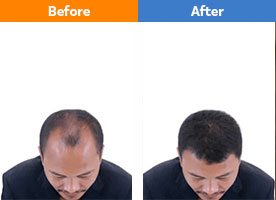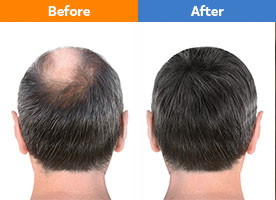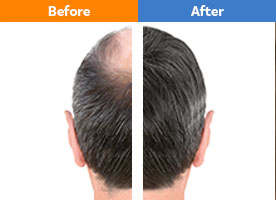
Select City
Restore your hairline and confidence with advanced hair transplant procedures at Pristyn Care. Our experienced hair transplant surgeons use safe and effective techniques like FUE to offer natural-looking, permanent results. Book your personalised hair restoration treatment with Pristyn Care and take the first step towards fuller hair.
Restore your hairline and confidence with advanced hair transplant procedures at Pristyn Care. ... Read More




Free Consultation

Free Cab Facility

No-Cost EMI

Support in Insurance Claim

1-day Hospitalization

USFDA-Approved Procedure
Choose Your City
It help us to find the best doctors near you.
Delhi
Kochi
Pune
Delhi
Gurgaon
Noida
Ahmedabad
Bangalore
A hair transplant is a surgical procedure that moves healthy hair follicles from one part of the scalp (typically the back or sides) to areas experiencing hair loss, such as the hairline, crown, or temples. It is also known as hair restoration treatment and is ideal for people with thinning hair or bald patches.
• Disease name
Hair Transplant
• Surgery name
Hair Transplantation
• Duration
4 to 8 Hours
• Treated by
Plastic surgeons

Fill details to get actual cost
| Number of Grafts | Follicular Unit Transplantation (FUT) | Follicular Unit Extraction (FUE) |
|---|---|---|
| Up to 1,000 | 4-6 hours | 4-5 hours |
| 1,000 - 2,000 | 5-7 hours | 5-6 hours |
| 2,000 - 3,000 | 6-8 hours | 6-7 hours |
| 3,000 - 4,000 | 7-9 hours | 7-8 hours |
| 4,000 - 5,000 | 8-10 hours | 8- 9 hours |
| 5,000 - 6,000 | 9-11 hours | 9-10 hours |



While hair transplant remains the most effective solution for restoring lost hair, there are several non-surgical hair transplant alternatives that may help slow down hair loss or improve hair density. Below are the common non-surgical hair restoration treatments:
Pristyn Care offers a range of modern hair transplant procedures to help restore natural hair growth. The right choice depends on your hair type, level of hair loss, and desired results. Here are the six types of hair transplant procedures available at Pristyn Care:
In this popular method, individual hair grafts are taken from the donor area (usually the back of the scalp) using a micro-punch tool and transplanted into bald or thinning areas.
Also known as the strip method, this technique involves removing a small strip of scalp from the donor area. Hair follicles are then separated and implanted where needed.
A refined form of FUE, DHI uses a special implanter pen to insert follicles directly into the scalp without creating recipient site incisions in advance.
This is an advanced version of FUE that uses sapphire blades to make incisions instead of traditional steel ones.
In this advanced method, hair follicles are extracted and implanted immediately, reducing the time follicles stay outside the body.
This high-precision method uses robotic technology to assist in extracting and implanting hair follicles.
A hair transplant procedure is done in two main steps using modern, safe, and effective techniques:
Diet & Lifestyle Consultation
Post-Surgery Free Follow-Up
Free Cab Facility

24*7 Patient Support
A hair transplant is generally a safe surgical procedure. However, like any surgery, it may involve certain risks and side effects. Most of these are temporary and manageable with proper after hair transplant care.
While rare, some individuals may experience the following risks during or after a hair transplant procedure:
A local anaesthetic is used during surgical hair transplant sessions. Some people may react to the medication used.
Though uncommon, infection at the donor site or recipient site may occur if proper hygiene is not maintained. This is preventable with antibiotics and sterile procedures.
Slight bleeding is normal, but in rare cases, patients may experience more than expected, especially in large sessions like 1000–5000 grafts hair transplant.
Tiny scars may form, especially with strip surgery (FUT), although FUE hair transplant and QHT hair transplant methods used at Pristyn Care significantly reduce visible scarring.
If hair grafts do not anchor properly, some may not grow.
Some patients may notice temporary numbness near the surgical site. This usually resolves within a few weeks.
Side effects are usually minor and fade within a few days to weeks after the hair growth surgery. These may include:
Small scabs may form where grafts were placed. These fall off naturally within 7–10 days.
Common during healing. Mild shampoos and topical treatments prescribed during after hair transplant care can help manage this.
Swelling on the scalp, forehead or around the eyes may occur for a few days after frontal hair transplant.
While a hair transplant is not painful in general, some soreness or tenderness may be felt post-surgery.
This may occur temporarily due to the healing of tissues.
You might notice hair fall around the hairline transplant or recipient site. This is normal and part of the hair growth after the hair transplant cycle.
A hair transplant is a highly effective and long-term solution for restoring natural hair growth in areas affected by hair thinning or baldness. Here are some of the key benefits of undergoing a hair transplant procedure:
After having hair transplant surgery, knowing what to expect can help you manage the healing process better. Here’s how to take care of yourself post-surgery:
| Hair Transplant Procedure | Description | Success Rate |
|---|---|---|
| Follicular Unit transplant (FUT) | Involves removing a strip of skin from the donor area and extracting follicular units for transplant | Success rates vary, typically 90-95% |
| Follicular Unit Extraction (FUE) | Involves individually extracting follicular units from the donor area without a strip of skin | Success rates vary, typically 80-90% |
| Robotic Hair transplant | Uses robotic technology to assist in the extraction and transplant process | Success rates vary, typically 85-95% |
FUSS (Follicular Unit Strip Surgery) involves removing a strip of scalp, while FUE hair transplant extracts individual hair grafts directly from the donor area. FUE is less invasive, leaves no linear scar, and is the preferred method at Pristyn Care.
You may be a good candidate if you have healthy donor hair, stable hair loss, and are in good overall health. It’s suitable for treating male pattern baldness, thin hair, and even hair transplant for alopecia in some cases.
Hair transplant cost depends on factors like the number of grafts (e.g., 1000–5000 grafts hair transplant), technique used (FUE or QHT hair transplant), and surgeon’s expertise. A consultation is needed for a personalised quote.
Signs of a bad transplant include unnatural hairline design, poor graft survival, infection, or uneven density. Choosing an experienced hair transplant surgeon and a trusted provider like Pristyn Care significantly reduces such risks.
A permanent hair transplant using FUE or QHT methods usually provides lifelong results, as transplanted follicles are resistant to DHT-related hair loss.
The procedure is done under local anaesthesia, so it’s mostly painless. Mild discomfort may occur during recovery, but it is temporary and manageable.
Following the after-hair transplant care instructions is important. This includes avoiding strenuous activity, protecting the scalp, and taking prescribed medications to support hair growth after hair transplant.
Yes, especially if you want a long-term solution for hair loss. A well-done surgical hair transplant boosts confidence and delivers natural-looking results when performed by qualified experts.
Hair restoration treatment is mainly used for genetic baldness, receding hairlines, thinning crowns, and in some cases, hair loss due to injury or scarring. It can also be tailored as hair implants for women.
Since hair growth surgery is considered cosmetic, it is generally not covered by health insurance in India. However, it’s best to check with your provider for exceptions.
Srinivas
Recommends
My name is Srinivas, I just want to say, Dr. chandni jain is truely amazing, my hair treatment here was the best. Thank you Chandni mam.
Azhaan Aziz
Recommends
Had hair transplant from here. Great treatment. Good thing is that after transplant also they took care of me.
Vikash kumar
Recommends
Finally did my hair transplant after thinking about it for 3 years. The result are better than I imagined. Hairline looks totally natural.
Om Prakash
Recommends
To be honest, I was scared about how it would look fake. But the transplant looks so natural, even my friends didn’t notice until I told them. Thanks chandni ji.
Amarnath
Recommends
Before surgery many doubts and afraid to do it. But pristyn care elantis and Dr chandni mam made me very comfort and cleared all doubts. Very happy after the hair transplant and result was good and happy with the result.
Yusuf Sheikh
Recommends
didn’t think I’d ever feel this confident again. Hair transplant really changed how I see myself. 2000 grafts transplant was best option for me.
.svg)
.svg)